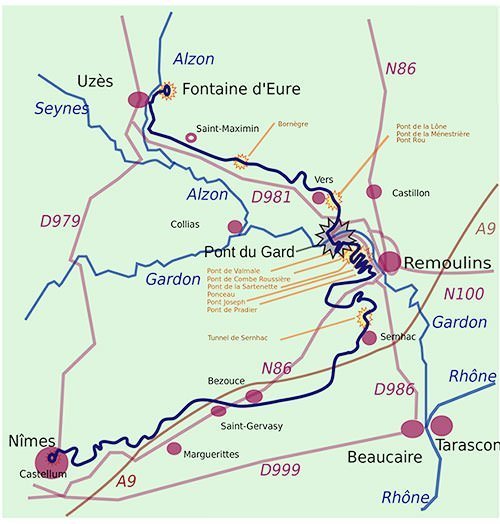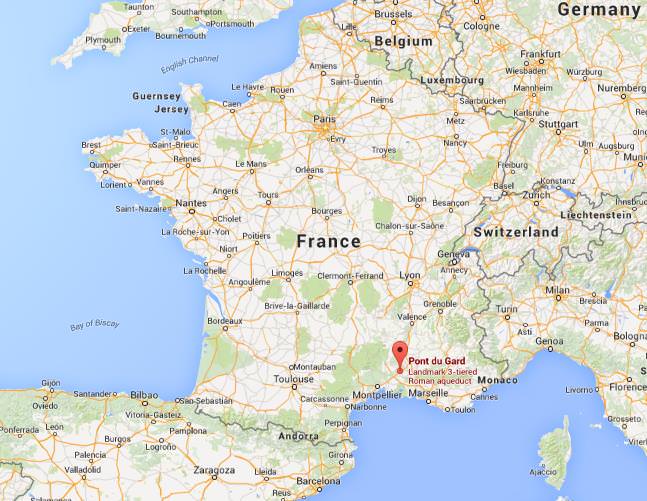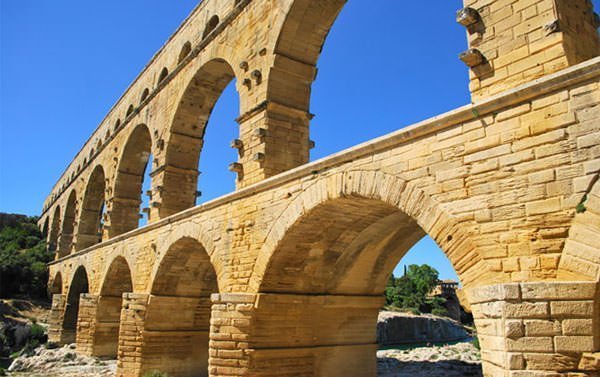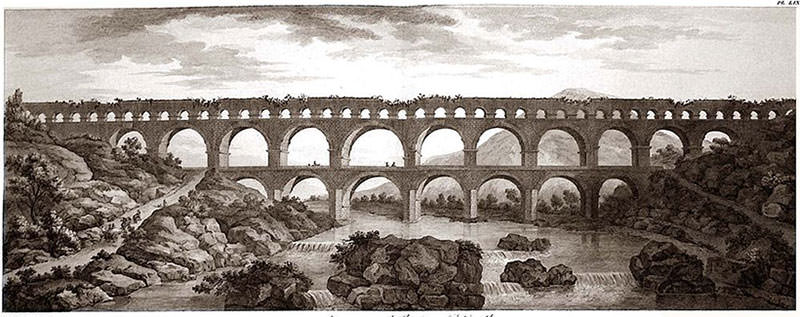Located near the town of Vers-Pont-du-Gard in southern France, Pont du Gard is an aqueduct bridge which is one of the most famous structures build by the ancient Romans. It was constructed around two thousand years ago as part of a 20 km long aqueduct to supply water to the city of Nimes, which had an estimated population of 60,000 then. Pont du Gard is the highest of all Roman aqueduct bridges and is considered a prime example of advanced Roman engineering. With more than a million visitors per year, it remains one of the most popular tourist destinations in France. Here are 10 interesting facts about the construction, history, dimensions and engineering of Pont du Gard.
#1 IT WAS PART OF A 50 KM LONG AQUEDUCT
Romans are famous for their advanced engineering accomplishments, among which is construction of numerous aqueducts. The word aqueduct is derived from the Latin aqua (“water”) and ducere (“to lead”). Aqueducts were conducted by Roman engineers to bring water from distant sources into cities and towns. Pont du Gard was part of a 50 km (31 miles) long aqueduct whose purpose was to supply fresh water to the Roman city of Nimes.

#2 PONT DU GARD WAS BUILT TO TRANSFER WATER OF THE AQUEDUCT ACROSS THE RIVER GARD
The straight-line distance between Nimes and the water source is only about 20 km (12 mi). However due to uneven terrain, the aqueduct takes a winding route measuring around 50 km (31 mi). The Gardon or Gard is a river in southern France. It was required to build a bridge across the river for successful completion of the aqueduct. The name Pont du Gard roughly translates to “Bridge over the river Gard”. It was built primarily as a channel for conveying water of the Nimes aqueduct across the river Gard.

#3 IT WAS PART OF A SYSTEM WHICH PROVIDED 200,000 CUBIC METERS Of Water
The Nimes aqueduct was built to channel water from the springs of the Fontaine d’Eure near Uzès to castellum divisorum, an open, circular basin of diameter 5.5 m and depth 1 m. From the basin it was distributed to fountains, baths and private homes of the city of Nimes. It is estimated that the aqueduct supplied the city with around 200,000 cubic meters of water a day. It took around 27 hours for the water to flow from its source to the city.

#4 IT WAS PROBABLY CONSTRUCTED IN THE MIDDLE OF FIRST CENTURY AD
It is not known with certainty when Pont du Gard was built. Usually, its construction is said to have occurred around 19 BC and is credited to Marcus Vipsanius Agrippa. Agrippa was son-in-law and lieutenant of the famous emperor Augustus. He undertook a campaign of building and improving public works in the empire, including several aqueducts. However, excavations suggest that Pont du Gard was constructed between 40 and 60 AD. Agrippa died long before that in 12 BC and the reign of Augustus was over in 14 AD. These estimates would put construction of the aqueduct in the reign of the emperor Claudius (41–54 AD).

#5 PONT DU GARD WAS CONSTRUCTED WITHOUT THE USE OF MORTAR
It is estimated that it took between 10 and 15 years to construct the Nimes aqueduct with Pont du Gard taking less than 5 years and a labor force of 800 to 1,000 workers. Like many of the best Roman constructions, Pont du Gard was built without mortar. The stones used to build the aqueduct bridge, some of which weigh up to 6 tons, were precisely cut to fit perfectly together eliminating the need for mortar. The limestone rocks were extracted from quarries near the site. Pont du Gard contains an estimated 50,400 tons of limestone with a volume of some 21,000 meters cube.

#6 IT IS CONSIDERED A MASTERPIECE OF ROMAN ENGINEERING
The Nimes aqueduct consists of several hundred meters of tunnels, 3 basins and some 20 bridges, of which the Pont du Gard is the most famous. The whole aqueduct descends in height by only 17 m (56 ft) over its entire length of 50 km, an average gradient of 34 cm/km. Pont du Gard descends by merely 2.5 cm, a gradient of only 1 in 3,000. These figures highlight the technical feat of Roman engineers who had to apply immense precision to make the water flow by the force of gravity all the way to Nîmes. Pont du Gard is considered an artistic and technical masterpiece of Roman architecture and engineering.

#7 PONT DU GARD IS THE HIGHEST OF ALL ROMAN AQUEDUCT BRIDGES
The Pont du Gard has three tiers of arches with the lower row having 6 arches of height 22 m (72 ft); the middle row having 11 arches of height 20 m (66 ft); and the upper row having 35 (originally 47) arches of height 7 m (23 ft). The width of the bridge varies from 9 m (30 ft) at the bottom to 3 m (9.8 ft) at the top. It has a length of 274 m (899 ft) and stands at a height of 48.8 m (160 ft). The Pont du Gard is the highest Roman aqueduct bridge.
#8 IT SURVIVED DECAY DUE TO ITS SECONDARY FUNCTION AS A BRIDGE
Nimes aqueduct kept functioning till at least fourth century AD after which its maintenance was neglected due to disruptions caused by invaders. Recent investigations have suggested that it was probably in use till as late as the sixth century by which time the water was used for irrigation. Though the aqueduct ultimately fell out of use, Pont du Gard remained largely intact due to its secondary function as a bridge across the valley. In 13th century, the French emperor granted the feudal lords of Uzes the right to charge tolls from those who used the bridge. In return the feudal lords were to ensure that Pont du Gard was well maintained.

#9 A BRIDGE ATTACHED TO IT WAS BUILT BY HENRI PITOT
Pont du Gard suffered serious damage in the 1620s when it was used to transport artillery during a war. It was repaired in 1703 by local authorities. In 1743 – 1747, French engineer Henri Pitot built a bridge, out from the lower tier of arches of Pont du Gard, for road traffic to pass through. Many people have since been critical of Pitot’s bridge. Novelist Alexander Dumas commented, “it was reserved for the eighteenth century to dishonor a monument which the barbarians of the fifth had not dared to destroy.” Most tourists that visit Pont du Gard use Pitot’s bridge to move through.

#10 PONT DU GARD IS A UNESCO WORLD HERITAGE SITE
Pont du Gard was at a serious risk of collapse by 1835 due to deterioration but in 1855–58 a reparation project was carried out under the direction of French architect Charles Laisne. Several subsequent projects have been carried out since then to consolidate the piers and arches of the bridge. In the last few years, Pont du Gard has survived major floods in 1958, 1998 and 2002. In 1985, Pont du Gard was added to UNESCO’s list of World Heritage Sites. It is one of France’s most popular tourist attractions, with 1.4 million visitors reported in 2001. Pont du Gard is one of the best preserved Roman aqueducts.

